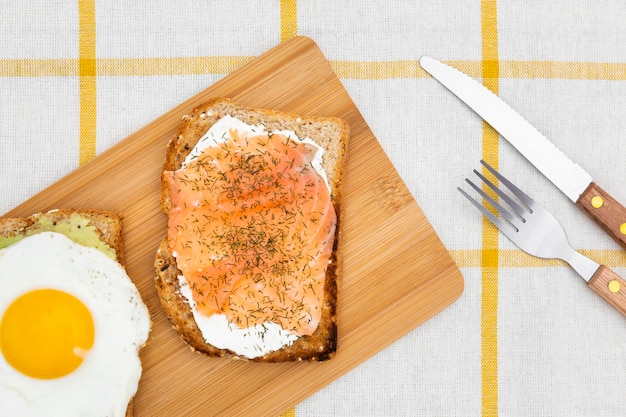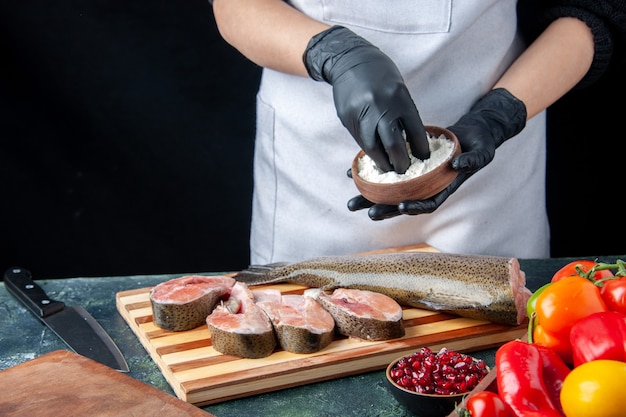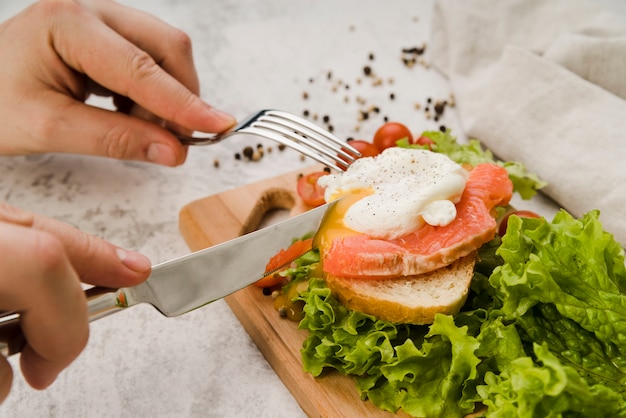Salmon, oh salmon, you culinary gem. You grace our plates with your vibrant hue and delicate flavour, a true star of the seafood world. But achieving that perfect "just right" doneness can feel like a culinary tightrope walk. overcooked salmon, sadly, is a tragedy – dry, flaky, and a culinary crime against a beautiful ingredient. But fear not, fellow food enthusiasts! I'm here to guide you through the intricacies of salmon cooking, sharing my personal tips and tricks to ensure a delicious and satisfying experience every time.
Part 1: choosing the right salmon – A Foundation for Flavor

The journey to delicious salmon starts with selecting the right fillet. You've got your farmed salmon, readily available and often budget-friendly, and then there's wild salmon, known for its deeper, more intense flavour but often carrying a higher price tag.
Wild vs Farmed: A Battle of Flavour
Personally, I gravitate towards wild salmon whenever possible, but ultimately, the choice comes down to your taste buds and budget. Now, at the fishmonger or supermarket, keep an eye out for these telltale signs of quality salmon:
Colour: A deep, vibrant colour is your cue. Avoid pale, washed-out hues – those fillets might not be at their freshest.
Flesh: Seek out a firm, springy texture. If the flesh feels flabby or mushy, it's a sign that the salmon might not be as fresh as it could be.
Smell: Fresh salmon has a mild, slightly salty scent, not a strong or fishy odor.
Skin On or Skin Off: A Matter of Preference
Now, the skin – a source of debate amongst chefs and home cooks. Skin-on salmon holds a special place in my heart. The skin helps keep the flesh moist during cooking and crisps up beautifully, adding texture and a subtle flavour. But, skinless fillets are perfectly acceptable if you prefer them. Just remember to score the skin of skin-on fillets with a sharp knife before cooking, preventing it from curling up and making cooking a bit more challenging.
Part 2: Prepping the Salmon: Setting the Stage for Success

With your chosen salmon fillet in hand, it's time to get it ready for its culinary transformation.
Pat It Dry: A Crucial Step
First, grab some kitchen paper and pat your fillet dry. This is a non-negotiable step. It ensures a nice, crispy skin and helps prevent steaming, which can lead to a less desirable texture.
Seasoning: A Symphony of Flavors
Now for the fun part – seasoning! Salt and pepper are the classic combo, but don't be afraid to unleash your creativity. Smoked paprika adds a smoky depth, lemon zest brightens the flavour, and fresh dill brings a delightful herbaceous touch. The possibilities are endless!
Part 3: Cooking Time: Unveiling the Perfect Doneness

Here comes the crucial part – the cooking time. But hold on, there's no one-size-fits-all answer! It hinges on a few key factors:
The Thickness Factor
Thicker fillets require more time than their thinner counterparts. As a general rule of thumb, a 1-inch thick fillet will need around 10-12 minutes, while a 2-inch thick one might require 15-20 minutes.
Cooking Method Matters
The method you choose will also influence the cooking time. Pan-frying or grilling tend to be faster than baking or roasting.
The Doneness Dilemma
And of course, your preference for doneness plays a significant role. A fan of rare salmon? Aim for a shorter cooking time. Prefer it medium or well-done? Then, extend that cooking time a bit.
Part 4: Pan-Frying Salmon: A Classic Technique for Crispy Perfection
Pan-frying is my go-to method. It's fast, easy, and results in that glorious crispy skin we all crave.
1. Heating Up: A Hot Start
Grab a heavy-bottomed pan and crank up the heat to medium-high. Add a little oil, olive oil or rapeseed oil are my usual picks, and make sure it's sizzling hot.
2. Introducing the Salmon: A Gentle Touch
Carefully place your salmon fillets in the hot pan, skin-side down. Don't overcrowd the pan, or the fillets won't cook evenly.
3. Cooking the First Side: A Patient Approach
Let the salmon cook undisturbed for about 3-4 minutes. The skin should become crispy and golden brown. Avoid moving the fillet around too much – we want that skin intact for a crispy delight!
4. Flipping the Salmon: A Delicate Manoeuvre
Once the skin is beautifully browned, it's time to flip those fillets. Do it gently, using a fish spatula or a large, flat turner to avoid breaking the skin.
5. The Doneness Check: A Peek Inside
To ensure that the salmon is cooked through, gently press the flesh with a fork. It should flake easily and have a slightly opaque appearance.
Part 5: baking salmon: A Hassle-Free Option for Even Cooking
If you're seeking a more hands-off approach, baking is your best friend.
1. Preheat the Oven: A Toasty Temperature
Set your oven to 375°F (190°C).
2. Prepare the Baking Dish: A Cozy Nest
Grab a baking dish or a piece of foil. If you're using foil, crimp the edges to create a little bowl.
3. Adding the Salmon: A Comfortable Arrangement
Place your salmon fillets in the baking dish, ensuring they're not too crowded.
4. Season and Dress: A Touch of Flavor
Drizzle a bit of oil over the salmon and sprinkle with your chosen herbs and spices. I often add a squeeze of lemon juice and a sprinkle of fresh dill for a vibrant touch.
5. Baking Time: A Gentle Transformation
Bake the salmon for 10-15 minutes. The exact time will depend on the thickness of your fillets.
Part 6: Grilling Salmon: A Summertime Delight with Smoky Flavors
Grilling is the perfect way to cook salmon during those warm summer months. It imparts a delightful smoky flavour.
1. Preheating the Grill: A Hot Embers
Get your grill nice and hot. For gas grills, aim for medium-high heat. For charcoal grills, you want hot coals.
2. Preparing the Grill: A Clean Slate
Clean your grill grates with a wire brush to remove any lingering food bits. Grease them with a little oil to prevent sticking.
3. Adding the Salmon: A Gentle Placement
Gently place your salmon fillets on the grill, skin-side down. Don't crowd the grill, allowing space for the fillets to cook evenly.
4. Cooking the First Side: A Crispy Result
Cook the salmon for about 3-4 minutes, or until the skin is crispy and golden brown. Be patient – flipping too early can lead to a broken skin.
5. Flipping the Salmon: A Careful Maneuver
Carefully flip the salmon fillets over to cook the other side. This should take about 3-5 minutes, depending on thickness and desired doneness.
6. Doneness Check: A Flaky Test
Use a fork to gently press the flesh. It should flake easily and have a slightly opaque appearance.
Part 7: Beyond the Basics: Elevating Your Salmon Game
Now, let's explore some creative twists to take your salmon cooking to the next level.
1. Glazing: A Shiny, Flavorful Finish
A simple glaze adds a touch of magic to your salmon. Sweet glazes like honey and soy sauce offer a delightful balance, while savoury glazes like lemon and garlic provide a vibrant burst of flavour. Simply brush the glaze over the salmon in the last few minutes of cooking.
2. Stuffing: A Hearty and Flavorful Centerpiece
For a more substantial meal, stuff your salmon with a delicious filling. A simple blend of herbs and cheese is always a winner, but you can also explore more elaborate options like spinach and ricotta.
3. Curing: A culinary adventure
If you're feeling adventurous, consider curing your salmon. This involves marinating the fish in a salt and sugar mixture, drawing out moisture and creating a firmer, more intense flavour. You'll find many recipes online, but it's an exciting way to experiment with different flavour profiles.
Part 8: Accompanying Your Salmon: The Perfect side dish Companions
What goes best with salmon? Well, the possibilities are vast, but here are a few classic pairings:
1. Green Vegetables: A Fresh and Vibrant Contrast
You can't go wrong with a side of green vegetables. Asparagus, broccoli, or green beans all complement salmon beautifully. Steam, roast, or sauté them for a delightful texture contrast.
2. Roasted Vegetables: A Sweet and Caramelized Delight
Roasting vegetables intensifies their natural sweetness and creates a lovely caramelized flavour. Try butternut squash, sweet potatoes, or Brussels sprouts for a delicious combination.
3. Salads: A Light and Refreshing Touch
A fresh salad adds lightness and colour to your meal. You can opt for a simple salad with lettuce, tomatoes, and cucumbers, or get creative with grilled vegetables, nuts, and a vinaigrette.
Part 9: Resting: The Key to Tender and juicy salmon
Don't rush to devour your salmon right after it's cooked. Let it rest for a few minutes, covered, before serving. This allows the juices to redistribute, resulting in a more tender and juicy salmon. Patience, my friends, is key!
Part 10: FAQs – Answering Your Salmon Queries
Got questions? I've got answers! Here are a few frequently asked questions about salmon cooking:
1. How Do I Know If My Salmon Is Cooked?
The best way to gauge doneness is by gently pressing the flesh with a fork. It should flake easily and have a slightly opaque appearance. You can also use a meat thermometer, inserting it into the thickest part of the fillet. It should register at least 145°F (63°C).
2. What If My Salmon Is Overcooked?
Overcooked salmon is dry and flaky. While there's no magic cure, you can try adding a sauce or topping to mask the dryness.
3. Can I Freeze Salmon?
Yes, you can freeze salmon, but it's best to freeze it raw. Wrap the fillets tightly in plastic wrap and then place them in a freezer-safe bag. frozen salmon can last for up to 3 months in the freezer.
4. What's the Best Way to Reheat Cooked Salmon?
You can reheat cooked salmon in the oven, microwave, or pan-fry it. If you're using the oven, preheat it to 350°F (175°C) and bake the salmon for about 10 minutes, or until heated through. For the microwave, heat it on medium power for about 30-60 seconds. To pan-fry it, heat a little oil in a pan over medium heat and cook the salmon for about 2-3 minutes per side.
5. Any Tips for cooking salmon with Skin On?
If you're cooking salmon with skin on, score the skin with a sharp knife before cooking. This helps prevent the skin from curling up. And remember, always cook the salmon skin side down first, giving it time to crisp up beautifully.
There you have it, a comprehensive guide to cooking salmon fillets, from choosing the right fillet to perfecting the doneness and adding creative twists. Go forth and cook delicious, juicy, perfectly cooked salmon, and enjoy the fruits of your culinary labour!
Everyone is watching

Corn on the Cob: The Ultimate Guide to Perfectly Cooked Ears
Healthy MealsAh, corn on the cob. Just the name evokes images of sunny days, barbecues, and that sweet, juicy flavour that ...

Scallops: The Ultimate Guide to Perfect Cooking
Healthy MealsAh, scallops. Those delicate, sweet, and utterly delicious morsels of the sea. They hold a special place in my...

Spaghetti Squash: The Ultimate Guide to Cooking and Serving
Healthy MealsRemember that time you saw spaghetti squash at the supermarket, looking all bumpy and strange, and thought, "W...

Salmon Cooking Times: Perfect Guide for Every Recipe
Healthy MealsLet me tell you, cooking salmon is an art form. It's all about getting that perfect balance: juicy and tender,...

Ham Cooking Time: How Long to Bake, Smoke, or Boil a Delicious Ham
Healthy MealsAh, ham. It's a classic, isn't it? A real crowd-pleaser, especially around holidays. And when done right, it'...
